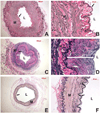Intimal thickness associated with endothelial dysfunction in human vein grafts
- PMID: 22763213
- PMCID: PMC3515722
- DOI: 10.1016/j.jss.2012.06.017
Intimal thickness associated with endothelial dysfunction in human vein grafts
Abstract
Background: Intimal hyperplasia is a complex process thought to be initiated by injury and is the leading cause of vein graft failure. In the present investigation, we hypothesized that the basal intimal thickness in the human saphenous vein is a predictor of endothelial dysfunction and, potentially, intimal hyperplasia.
Methods: Human saphenous veins were obtained during coronary artery bypass surgery. The segments were contracted with phenylephrine and relaxed with carbachol to determine the endothelial-dependent relaxation. The vein segments were fixed in 10% buffered formalin and grown for 14 d in high-serum culture and then fixed in formalin. The fixed tissues were stained with Verhoeff-Van Gieson, and the average intimal and medial thicknesses were calculated using light microscopy and a computerized image analysis system.
Results: The human saphenous veins displayed varying amounts of basal intimal thickness (range 18.80-241.3 μm). The endothelial-dependent relaxation of the veins was highly variable, with values ranging from 0% to 27.59%. Human saphenous veins with a basal intimal thickness greater than 120 μm had significantly less endothelial-dependent relaxation (8.90% ± 6.32%) than those with a basal intimal thickness less than 120 μm (21.97% ± 10.64%). Endothelial dysfunction correlated with a basal intimal thickness greater than 120 μm (P = 0.02). The basal intimal thickness also correlated with increased intimal thickness after 14 d in organ culture (P = 0.0001).
Conclusions: A basal intimal thickness greater than 120 μm is a predictor of endothelial dysfunction. Also, because a greater basal intimal thickness correlated with an increased intimal thickness after organ culture, the basal intimal thickness might predict vein graft failure owing to intimal hyperplasia.
Published by Elsevier Inc.
Figures





Comment in
-
Vein graft harvesting--handle with care.J Surg Res. 2013 Dec;185(2):507-8. doi: 10.1016/j.jss.2012.08.002. Epub 2012 Aug 25. J Surg Res. 2013. PMID: 22959210 No abstract available.
Similar articles
-
Increased connexin43 expression in human saphenous veins in culture is associated with intimal hyperplasia.J Vasc Surg. 2005 Jun;41(6):1043-52. doi: 10.1016/j.jvs.2005.02.036. J Vasc Surg. 2005. PMID: 15944608
-
Intimal hyperplasia and expression of transforming growth factor-beta1 in saphenous veins and internal mammary arteries before coronary artery surgery.Ann Thorac Surg. 2004 Oct;78(4):1312-8. doi: 10.1016/j.athoracsur.2004.02.066. Ann Thorac Surg. 2004. PMID: 15464491
-
Modulation of phosphatidylinositol 3-kinase signaling reduces intimal hyperplasia in aortocoronary saphenous vein grafts.J Thorac Cardiovasc Surg. 2005 Jun;129(6):1405-13. doi: 10.1016/j.jtcvs.2004.11.048. J Thorac Cardiovasc Surg. 2005. PMID: 15942585
-
Activation and inflammation of the venous endothelium in vein graft disease.Atherosclerosis. 2017 Oct;265:266-274. doi: 10.1016/j.atherosclerosis.2017.08.023. Epub 2017 Aug 24. Atherosclerosis. 2017. PMID: 28865843 Review.
-
Acute shear stress and vein graft disease.Int J Biochem Cell Biol. 2022 Mar;144:106173. doi: 10.1016/j.biocel.2022.106173. Epub 2022 Feb 10. Int J Biochem Cell Biol. 2022. PMID: 35151879 Review.
Cited by
-
Vein graft failure.J Vasc Surg. 2015 Jan;61(1):203-16. doi: 10.1016/j.jvs.2013.08.019. Epub 2013 Oct 3. J Vasc Surg. 2015. PMID: 24095042 Free PMC article. Review.
-
Calcification of Human Saphenous Vein Associated with Endothelial Dysfunction: A Pilot Histopathophysiological and Demographical Study.Front Surg. 2017 Feb 9;4:6. doi: 10.3389/fsurg.2017.00006. eCollection 2017. Front Surg. 2017. PMID: 28232909 Free PMC article.
-
Traditional graft preparation decreases physiologic responses, diminishes viscoelasticity, and reduces cellular viability of the conduit: A porcine saphenous vein model.Vasc Med. 2016 Oct;21(5):413-421. doi: 10.1177/1358863X16649040. Epub 2016 May 23. Vasc Med. 2016. PMID: 27216870 Free PMC article.
-
Peritoneal pre-conditioning impacts long-term vascular graft patency and remodeling.Biomater Adv. 2023 May;148:213386. doi: 10.1016/j.bioadv.2023.213386. Epub 2023 Mar 16. Biomater Adv. 2023. PMID: 36948108 Free PMC article.
-
The Case for Endothelial Preservation via Pressure-Regulated Distension in the Preparation of Autologous Saphenous Vein Conduits in Cardiac and Peripheral Bypass Operations.Front Surg. 2016 Sep 22;3:54. doi: 10.3389/fsurg.2016.00054. eCollection 2016. Front Surg. 2016. PMID: 27713879 Free PMC article. No abstract available.
References
-
- Bonow RO, Bennett S, Casey DE, Jr, et al. ACC/AHA Clinical Performance Measures for Adults with Chronic Heart Failure: a report of the American College of Cardiology/American Heart Association Task Force on Performance Measures (Writing Committee to Develop Heart Failure Clinical Performance Measures): endorsed by the Heart Failure Society of America. Circulation. 2005;112:1853. - PubMed
-
- Motwani JG, Topol EJ. Aortocoronary saphenous vein graft disease: pathogenesis, predisposition, and prevention. Circulation. 1998;97:916. - PubMed
-
- Conte MS, Mann MJ, Simosa HF, et al. Genetic interventions for vein bypass graft disease: a review. J Vasc Surg. 2002;36:1040. - PubMed
-
- Alexander JH, Hafley G, Harrington RA, et al. Efficacy and safety of edifoligide, an E2F transcription factor decoy, for prevention of vein graft failure following coronary artery bypass graft surgery: PREVENT IV: a randomized controlled trial. Jama. 2005;294:2446. - PubMed
Publication types
MeSH terms
Grants and funding
LinkOut - more resources
Full Text Sources
Other Literature Sources

